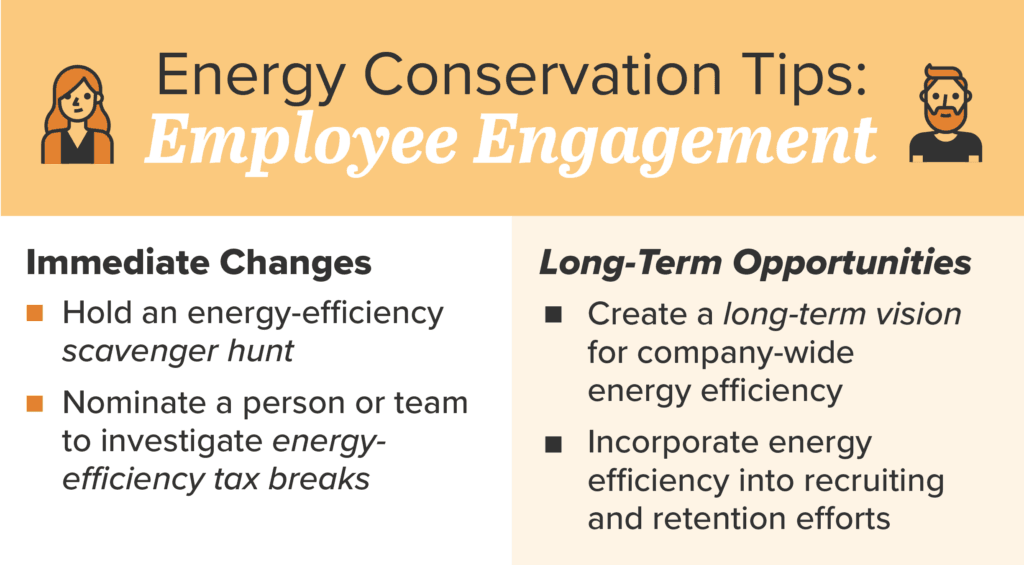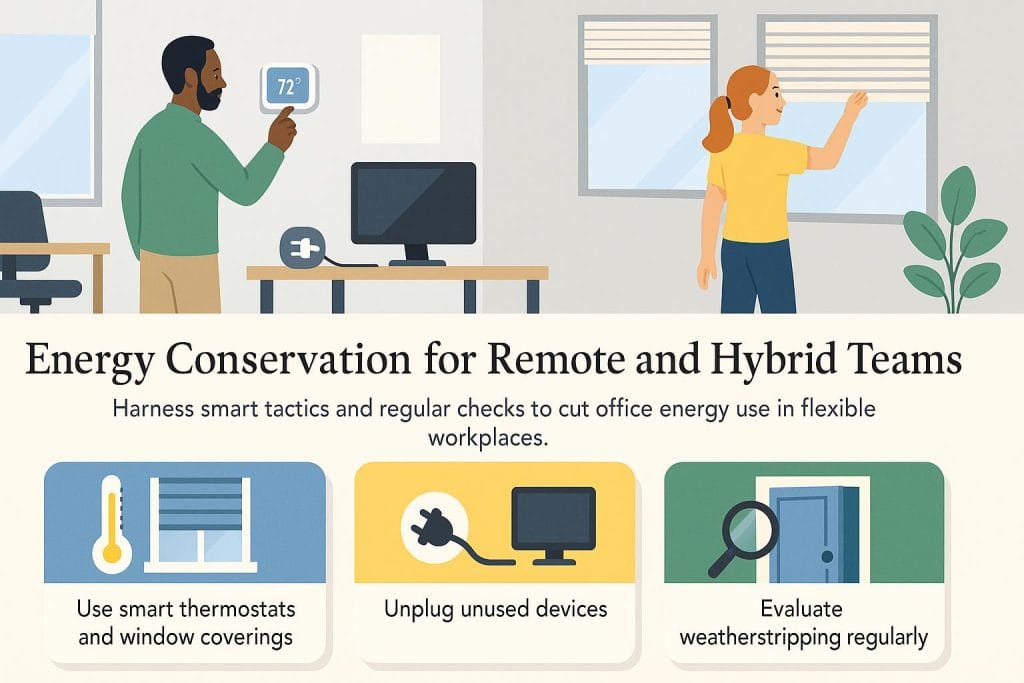Business.com aims to help business owners make informed decisions to support and grow their companies. We research and recommend products and services suitable for various business types, investing thousands of hours each year in this process.
As a business, we need to generate revenue to sustain our content. We have financial relationships with some companies we cover, earning commissions when readers purchase from our partners or share information about their needs. These relationships do not dictate our advice and recommendations. Our editorial team independently evaluates and recommends products and services based on their research and expertise. Learn more about our process and partners here.
Small Business Guide to Energy Conservation
Energy conservation can give your business a competitive advantage while helping the environment.

Table of Contents
Saving energy is more than good practice — it’s a smart way to cut costs and stay competitive. Utility bills can add up to thousands each year, especially in larger offices or older buildings that aren’t energy efficient.
In fact, the National Renewable Energy Laboratory (NREL) reports that many small businesses occupy buildings under 50,000 square feet, and together, these smaller spaces account for 44 percent of all U.S. commercial building energy use. That means even modest-sized offices can have an outsized impact on both the environment and their own utility expenses.
Luckily, there are simple steps you can take to bring energy use under control. Conserving energy lowers overhead costs, reduces your carbon footprint and can even give you a public relations boost when you share your efforts with customers and the community.
How your business can save energy
This guide offers actionable advice surrounding the primary opportunities for energy savings:
Each of these plays a role in lowering utility bills and cutting waste. Let’s walk through them one by one and show how small changes can add up to big savings.
Lighting
Lighting makes up a big share of office energy use, but it’s also one of the easiest places to cut costs and conserve energy. Upgrades in bulbs, fixtures and controls can quickly pay for themselves.
Lighting in large spaces
The areas in your office space where your employees work need steady light throughout the day. One of the easiest and most impactful upgrades is switching from incandescent or fluorescent bulbs to LEDs. The U.S. Department of Energy reports that LEDs use at least 75 percent less energy and last up to 25 times longer, making them the clear choice for high-use areas.
- Fluorescent light tubes: Many offices still rely on fluorescent tubes, which are more efficient than old incandescent bulbs. However, a growing number of states are phasing out fluorescents, meaning future replacements will almost certainly need to be LEDs or another compliant option. If your office still uses fluorescent fixtures, now is the time to start planning a transition.
- Fluorescent light ballasts: If you’re not ready for a full lighting overhaul, upgrading to modern electronic ballasts can reduce flickering, cut excess heat and improve efficiency in the short term. Still, LEDs remain the long-term solution.
Lighting in conference rooms, bathrooms and break rooms
Spaces that aren’t used all the time don’t need full-time lighting. Here are a few smart ways to cut waste:
- Occupancy sensors: These devices automatically turn lights on when someone enters a room and off when it’s empty. They also add a safety benefit since no one has to walk into a dark space.
- Vacancy sensors: Similar to occupancy sensors, vacancy sensors keep lights off until someone flips the switch. When the person leaves, the lights shut off automatically — a good fit for rooms with plenty of natural light.
- New lighting fixtures: Older fixtures sometimes trap light for aesthetic reasons. Replacing fixtures with modern designs that use better reflectors and geometry pushes more light into the room, giving you more brightness with less energy.
Outdoor lighting
Better lighting around your business makes the property safer and more inviting to customers. For exterior spaces, solar lights are one of the most cost-effective green energy options. They’re simple to install, require little upkeep and run on free, renewable energy.
Keep these points in mind when using solar lighting:
- Make sure the area gets enough direct sunlight each day to keep the lights powered.
- Clean the sensors regularly — dirt and debris can block the panels and reduce performance.
Natural light

Modern office buildings often feature large windows, and smart businesses make the most of that free resource. Maximizing natural light reduces reliance on artificial lighting while also lowering costs.
Because lighting needs vary, it helps to involve employees. Ask for their input on how to make better use of daylight, whether that’s rearranging desks, adjusting blinds or simply encouraging people to use natural light when possible.
Heat regulation
A comfortable office temperature keeps employees productive, but maintaining it can drive up energy costs. Fortunately, new technology and a few common-sense strategies can reduce those bills.
- Smart thermostats: The latest wireless thermostats make temperature control far easier — no more relying on the last person out of the office to adjust the heat or AC. “The smart thermostat can also ‘learn’ our temperature preferences and the hours of their use so that we get our space to our liking, but only when we need to,” explained Doug Keller, former community manager at Payless Power. ENERGY STAR-certified smart thermostats save, on average, about 8 percent on heating and cooling costs or around $50 per year per household, so they can quickly pay for themselves.
- Fans: Sometimes, low-tech works best. Fans don’t use much energy but make people feel cooler by circulating air. Instead of blasting the AC, consider fans as a cost-effective way to keep employees comfortable, and encourage them to ask for one if they need it.
- Window coverings: Shades, blinds and awnings can block excess heat in the summer while retaining warmth in colder months. According to the DOE, awnings alone can cut solar heat gain by up to 65 percent on south-facing windows and 77 percent on west-facing ones. For maximum efficiency, work with a professional to choose the right treatments for your building’s orientation and local climate.
- Trees: Strategically planted trees offer natural shade, lower cooling bills and enhance curb appeal. Deciduous trees are especially useful since they provide shade in the summer and let sunlight through in the winter. Consult a local landscaper to choose species that thrive in your region.
- Casual dress: Comfortable employees are more productive employees. Relaxing your dress code in warmer months — swapping suits for polos or lightweight attire — can help reduce reliance on air conditioning.
- Weatherstripping and leaks: Gaps around windows and doors can waste hundreds of dollars in heating and cooling. Ask employees to flag defective weatherstripping or drafty spots near their desks. You’ll save money, and as a bonus, involving staff in the process can boost employee engagement.
Equipment upgrades
Office equipment often accounts for a significant share of energy use. Fortunately, the DOE’s ENERGY STAR program makes it easier to identify the most efficient options, and in specialized industries, an energy audit can reveal even greater opportunities. The NREL’s Energy Efficiency Measure Selection Tool, for example, helps businesses find upgrades that can deliver around 20 percent energy savings cost-effectively.
Here are some places where upgrades can help you conserve energy and save money.
- Appliances: Updating common items like coffee makers, refrigerators and washing machines can make a big difference. Many ENERGY STAR commercial appliances are 10-20 percent more efficient than comparable standard models, often offering payback within three to five years, depending on usage, utility rates and replacement costs. “In the last 10 years, there’s been a real revolution in energy efficiency, so if you’re using appliances that are older than 10 years, you’re almost certainly wasting energy,” said Ian Wright, investigation officer for the United Kingdom’s Department for Business, Energy and Industrial Strategy
- Laptops vs. desktops: When it comes to computing, laptops are generally the more efficient choice. They’re built for battery power, which means fewer high-consumption components like dedicated video cards. If you’re replacing desktops, consider whether employees could work just as effectively on less energy-intensive laptops, and look for ENERGY STAR certified models to maximize savings.
- Chargers, screens and other always-on devices: Small devices add up, too. Battery chargers draw power even when idle, and screens in screensaver mode consume just as much energy as when in use. Encourage employees to unplug chargers and power down equipment when it’s not needed. Even small changes across a team can stop these “energy leaks” from draining your budget.

Employee engagement
Involving employees is one of the most effective ways to make energy conservation stick. Research from the Smart Energy Consumer Collaborative shows that 73 percent of small and medium-sized businesses are interested in demand response programs that lower costs during peak energy periods — and employee buy-in is key to making those programs work.
Here are a few ways to get staff engaged:
- Create a green team: Sustainability consultant Josh Prigge recommends forming a cross-functional green team of employees who meet monthly to brainstorm new ideas. These groups don’t just save energy; they also support employee development, improve communication across departments and boost job satisfaction.
- Appoint an energy conservation officer: Another option is designating an internal energy officer to monitor usage and recommend improvements. This person can also research financial incentives. Under the Inflation Reduction Act, many qualified upgrades are eligible for 30 percent federal tax credits through 2032. For a broader view of federal, state and local incentives, the DSIRE database is the best place to start.
Energy conservation for remote and hybrid teams

Today, many businesses operate with remote work plans or hybrid and flexible work arrangements. You can champion energy conservation efforts in these work models in the following ways.
1. Conserve energy when your team is entirely remote.
Employers with a fully remote staff may not need permanent office space — the ultimate energy savings. If you maintain an office for occasional meetings or special uses, consider these practices:
- Implement conservation tactics: Smart thermostats and window coverings can keep the space cool and comfortable without wasting energy.
- Watch for unnecessary expenditures: Unplug unused devices and appliances so they don’t draw standby power.
- Evaluate your building regularly: Check windows and doors for faulty weatherstripping or other leaks that may drive up energy costs.
Additionally, many utility companies offer free or low-cost energy efficiency assessments for small businesses. These evaluations can identify quick changes that lead to meaningful savings.
2. Conserve energy when you have a hybrid workforce
Hybrid schedules allow employees to split their time between the office and home. To avoid wasting energy on unused space, consider these approaches:
- Opt for a smaller office space: If only a portion of your team is onsite at any given time, you may not need a large office. Downsizing can reduce both utility use and leasing costs.
- Use energy-saving tools: Occupancy and vacancy sensors ensure lights and other systems shut off automatically when rooms are empty, cutting unnecessary consumption.
Sustainability as a competitive advantage
Conserving energy can bring welcome cost savings and better position a business in the marketplace. “The slightest persistent waste can brutalize a small business where risk tolerance is low and margins are tight,” explained Tom Paladino, founder and CEO of Paladino Consulting, an award-winning, green building consulting firm. “These businesses must eliminate any waste that they can to protect the bottom line.”
For Paladino, his company’s commitment to energy conservation is more than just a way to save money.
“We compete with industry giants for customers and talent,” Paladino shared, “and when people experience our LEED Gold-certified office with its standing desks, organic fruit, operable windows, abundant plants and engaged talent, it makes a difference.”
There’s no downside to energy conservation in business. Numerous benefits ensue when companies make these practices permanent, integral operational elements.
“The most important thing for small businesses to understand is that going green in business is not a strategy to tack on to their business model,” Paladino said. “Going green should be integrated into your operating philosophy. Whether you do it for the planet or do it for the profit or do it for the people, sustainability programs can improve your top and bottom line with a modest budget or no added cost at all.”
